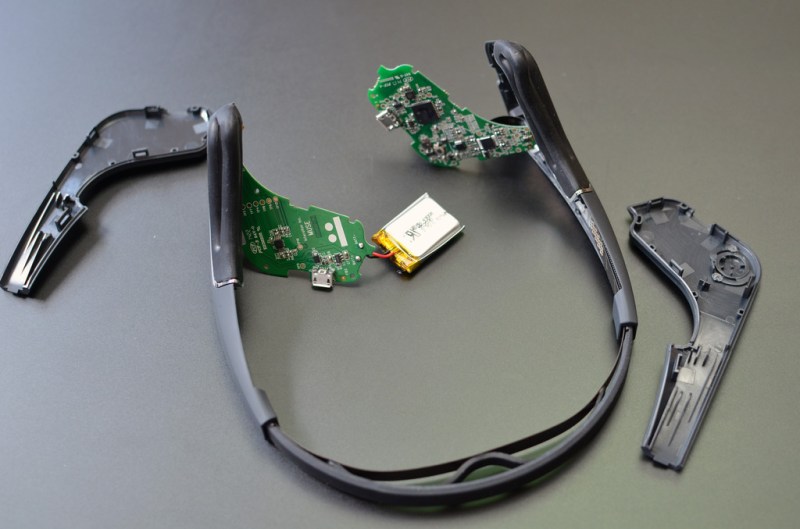[Lady Ada] over at Adafruit just did a delightful tear down of the Muse EEG headset.
The Muse headset is a rather expensive consumer-grade EEG headset that promises better meditation with the ability to track your brainwaves in order to go into a deeper trance. We’re not much for meditating here at Hackaday, but the EEG sensors really do work. It’s pretty cool to see the insides of this without forking out $300 ourselves for one we might break.
Like most EEG headsets, they weren’t really designed to be worn while sleeping. Two bulky pods over the ears hold the battery and charging circuit on one side, and the brains on the other. The neat part about it is a little adjustable metal piece which allows for adjustment on the strap while maintaining all the electrical connections. A flexible circuit houses forehead electrodes which go along the length of the band.
In the past we’ve seen work done on the Lucid Scribe project, using a modified Neurosky Mindwave EEG (at $99 it’s much cheaper to hack). The idea is to be able to monitor your sleep cycles accordingly, and then give audible cues to the dreamer in order to “wake up” inside the dream. Think of the Inception music.
Unfortunately it doesn’t look like the Muse will be any better for lucid dreaming. If you were able to decouple the electrodes from the rest of the headset, then it might just work.
















I have an old Mindflex toy earmarked for something similar. Like wake you up at the time closest to your alarm in between deep sleep cycles for maximum rest
There’s an app that does this, called sleep time (free on android). Works pretty well by using the phones accelerometer to watch movement of your bed.
Sounds interesting, but it also sounds like the latest update just ruined it.
That’s an interesting idea. The phone apps that do this monitor movement, but doing it by monitoring brain activity could be a lot better–or at least different.
The Zeo sleep-tracking system used a forehead strap with electrode pads to measure EEG (pretty sure it was EEG, not eye-motion muscles, though there have been lucid-dreaming devices that look for REM), and low-power radio (probably Polar?) back to the control center / user interface / alarm clock. It was able to give a much more accurate evaluation of your sleep state than the simple accelerometer apps on phones or Fitbit-like sensors – tracked when you were in deep sleep, light sleep, or REM. Unfortunately, they’re out of business, and don’t make the electrode pads any more, which wear out after a while.
The Fitbit-clone I currently use gives me some information, but this one needs you to tell it before you’re going to sleep so it can change modes, and the other day I woke up about 5, couldn’t get back to sleep, came downstairs and read the computer for a couple of hours, and since the sensor was in my pocket and not on a wrist band, it decide I wasn’t moving around so I’d gone back to sleep :-)
FYI, if you still have your Zeo, you can easily make replacement Zeo headbands:
http://www.instructables.com/id/DIY-Replacement-Zeo-Sleep-Monitor-Headband-Sensor/
Has anyone ever played with the OCZ NIA ?
Rob over at luciddreamart hacked a LED motion sensor into a NIA: https://luciddreamart.wordpress.com/projects/#ocz-nia-hack, in search of eye movements.
“Two bulky pods over the ears hold the battery and charging circuit on one side, and the brains on the other. ”
I know, I know. It just sounds funny.
I do wonder if something similar could be done using the Hackaday.io Biosignal library project. An intraoperative uses similar electrode placement and FFT analysis to determine level of consciousness.
*medical device
(An edit button would be nice.)
What a shitty teardown in term of describing the heart of it: the analog frontend. Little more than mentioning its presence. She should post a circuit diagram or at least tell as which principle is used for measurement: single ended, differential, three opam INA etc. This is useless. Of course the headset consists out of a cpu, an analog forntend, a battery and a bluetooth radio. I wouldn’t need to take it apat for that information. Sloppy, sloppy work-
It’s probably an integrated front end from some like TI. http://www.ti.com/paramsearch/docs/parametricsearch.tsp?family=analog&familyId=1916&uiTemplateId=NODE_STRY_PGE_T#p1028=1;8
Unlikely, too expensive and not necessary, but whatever it is a teardown should answer the question.
Does that say 0.925Wh? Doesn’t look much smaller than the 3.33Wh cell in a Blu charger pack. So while you have it apart, might as well upgrade the battery.
You guys need to check out the Aurora headband by Iwinks. It’s an EEG headset designed specifically for lucid dreaming.
My Muse headband battery needs replacement. I have identified it as a very high quality 552030 Lithium Polymer 250mAh 0.925Wh 3.7V which sells for about $5 individually from China. When it arrives I’m going to solder it in.
Mine too. Thank you for identifying the battery type! Do you think this a simple job for someone who has very limited experience with soldering? Do you have any tips for how to do this?
It’s pretty easy, I just replaced mine this week and made a video showing how: https://fatseas.com/2017/06/30/i-replaced-my-muse-headband-battery/
Did you end up replacing your battery?
Hi Andrew! Too much on my hands since becoming a father, but now looking into it again :)
I really appreciate your demonstration on youtube! Thank you!
It seems like the 552030 is out of production, but the 502030 is everywhere, seems to be the right size and with the same specs:
https://www.ebay.com/itm/5-pcs-3-7V-250mAh-502030-Lipo-Polymer-Battery-li-ion-For-Bluetooth-GPS-MP3-GPS/172913751631?hash=item284276764f:g:w9AAAOSw3utY5HyS
Seems OK doesn’t it?
Yes that’s the same model battery that I used. It’s a fraction larger than the original but I managed to fit it in. There’s a little plastic tab inside the case that locates the original battery that gets in the way. Just cut it off or flatten it. Good luck!
Great! Thank you again!
GIMANA CARA BUATINNYA….
;@^#^×,@*
*cough* *cough* https://hackaday.com/2009/10/21/mind-control-via-serial-port/